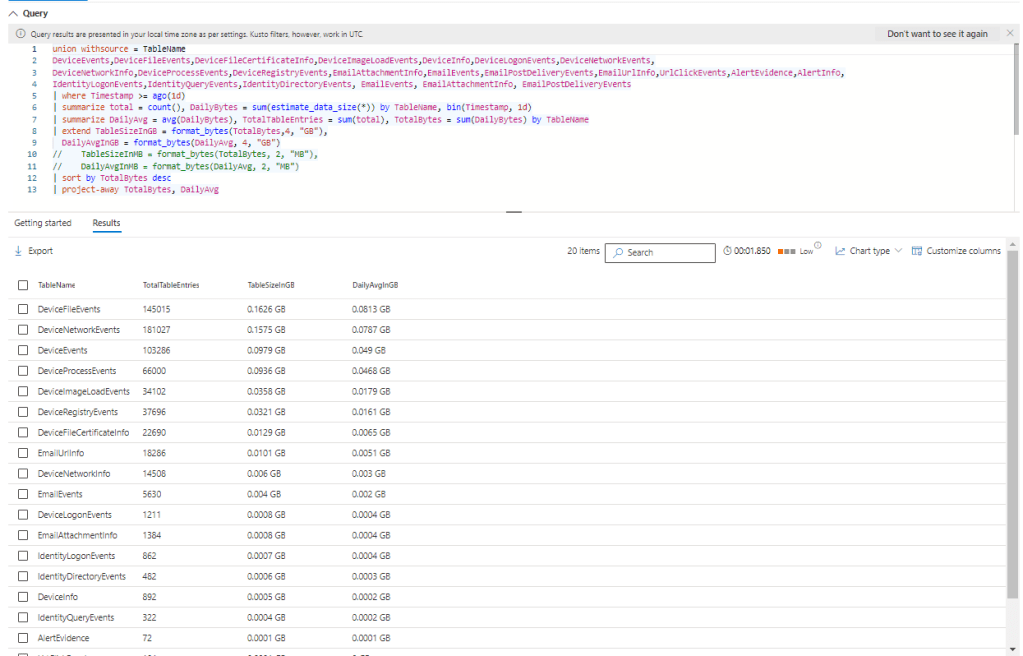In the dynamic landscape of cybersecurity, staying ahead of potential threats requires a keen understanding of the data generated by security tools. Microsoft Defender for Endpoint stands as a stalwart guardian, offering robust protection against evolving risks. To harness the full potential of Defender for Endpoint, we turn our attention to the power of the Kusto Query Language (KQL). In this blog post, we embark on a journey through a comprehensive KQL script meticulously crafted for hunting and analyzing data within Defender for Endpoint. This script serves as a beacon, illuminating the path to unlocking valuable insights into daily activities and data sizes across diverse tables. Join us as we dissect each section of this script, revealing the intricacies that make it an indispensable asset in the arsenal of cybersecurity professionals.
Complete KQL Script
union withsource = TableName
DeviceEvents, DeviceFileEvents, DeviceFileCertificateInfo, DeviceImageLoadEvents, DeviceInfo, DeviceLogonEvents, DeviceNetworkEvents,
DeviceNetworkInfo, DeviceProcessEvents, DeviceRegistryEvents, EmailAttachmentInfo, EmailEvents, EmailPostDeliveryEvents, EmailUrlInfo, UrlClickEvents, AlertEvidence, AlertInfo,
IdentityLogonEvents, IdentityQueryEvents, IdentityDirectoryEvents, EmailEvents, EmailAttachmentInfo, EmailPostDeliveryEvents
| where Timestamp >= ago(1d)
| summarize total = count(), DailyBytes = sum(estimate_data_size(*)) by TableName, bin(Timestamp, 1d)
| summarize DailyAvg = avg(DailyBytes), TotalTableEntries = sum(total), TotalBytes = sum(DailyBytes) by TableName
| extend TableSizeInGB = format_bytes(TotalBytes,4, "GB"),
DailyAvgInGB = format_bytes(DailyAvg, 4, "GB")
// TableSizeInMB = format_bytes(TotalBytes, 2, "MB"),
// DailyAvgInMB = format_bytes(DailyAvg, 2, "MB")
| sort by TotalBytes desc
| project-away TotalBytes, DailyAvg
- Union Operation:
- In this section, we use the
unionoperator to combine data from multiple tables. Thewithsourceoption adds a column namedTableNameto identify the source table for each record.
- In this section, we use the
- Filtering by Timestamp:
- This line filters the records based on the
Timestampfield, selecting only those that occurred within the last 1 day (ago(1d)).
- This line filters the records based on the
- Summarization:
- The
summarizestatement calculates the total count and daily sum of estimated data size for each table. The results are aggregated byTableNameand binnedTimestampinto 1-day intervals.
- The
- Further Summarization:
- Another
summarizestatement further aggregates the data, calculating the average daily bytes (DailyAvg), total table entries (TotalTableEntries), and total bytes (TotalBytes) for each table.
- Another
- Extension with Size Formatting:
- The
extendstatement adds new columns to the result, formatting the total bytes and daily average bytes into gigabytes.
- The
- Sorting and Projecting:
- The
sortstatement arranges the results in descending order based on total bytes (TotalBytes). Theproject-awaystatement removes unnecessary columns (TotalBytesandDailyAvg) from the final output.
- The
Conclusion:
By delving into the intricacies of this KQL script, we’ve uncovered a powerful approach to extracting valuable insights from Defender for Endpoint data. This script not only aggregates and summarizes data but also formats it for easy interpretation. Incorporate this script into your security analysis toolkit to gain a comprehensive understanding of daily activities and data sizes, empowering you to make informed decisions to enhance your organization’s cybersecurity posture.
